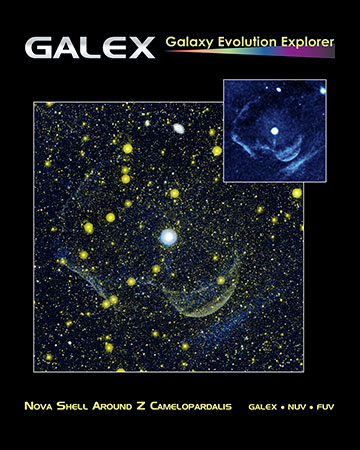GALEX Image

Nova Shell Around Z Camelopardalis
The larger image, a composite from the near-ultraviolet and far-ultraviolet detectors on NASA's Galaxy Evolution Explorer, shows the Z Camelopardalis (Z Cam) stellar system and a massive shell around it. The inset image contains data from the observatory's far- ultraviolet detector, and has been processed to eliminate most of the foreground and background stars and galaxies, while enhancing Z Cam and the shell.
In the composite image, Z Cam is the largest white object in the image, located near the center. Parts of the shell are seen as a lobe-like, wispy, yellowish feature below and to the right of Z Cam, and as two large, whitish, perpendicular lines on the left. The bluish streak in the bottom right corner is reflected dust that may or may not be related to Z Cam. Numerous foreground and background stars and galaxies are visible as yellow and white spots. The yellow objects have predominantly near-ultraviolet emissions, while the white objects are close to a nearly equal mix of near-ultraviolet and far-ultraviolet emissions.
In the inset image, Z Cam is the large white object located near the center. Parts of the shell appear as a lobe-like, light-blue feature below and to the right of Z Cam, and as two large, light-blue, perpendicular lines on the left. Most of the background galaxies and stars have been eliminated by the processing of the image, although a few linger as white spots near the top, as does the light-blue streaky clump of reflected dust in the bottom right corner.
Z Cam is a binary, or double-star, system. It has a collapsed, dead star, or white dwarf, and a companion star, as well as a ghostly shell surrounding the system. The massive shell provides evidence of material ejected during and swept up by a powerful classical nova eruption, which likely occurred a few thousand years ago.
There are two classes of exploding binary star systems, or cataclysmic variables: recurrent dwarf novae, which erupt in smaller, "hiccup-like" blasts, and classical novae, which undergo a huge explosion thousands of times more powerful than dwarf novae.
Z Cam was one of the first known recurrent dwarf novae. Yet the shell of ionized gas around Z Cam detected by the Galaxy Evolution Explorer can only be explained as the remnant of a full-blown classical nova explosion. The discovery of the shell provides the first evidence that some binary systems undergo both types of explosions. Previously, a link between the two types of novae had been predicted, but there was no evidence to support the theory.
The Galaxy Evolution Explorer first began imaging Z Cam in 2003; this image was taken on Jan. 25, 2004. The type of emission found around Z Cam is most visible in far- ultraviolet wavelengths.
Credit: NASA/JPL-Caltech/M. Seibert(OCIW)/T. Pyle(SSC)/R. Hurt(SSC)
Release Date
March 7, 2007
Download Options
- Full Resolution TIFF [2400x3000, 8.9 MB]
- Full Resolution JPEG [2400x3000, 4.6 MB]
- Screen Resolution JPEG [360x450, 56 KB]